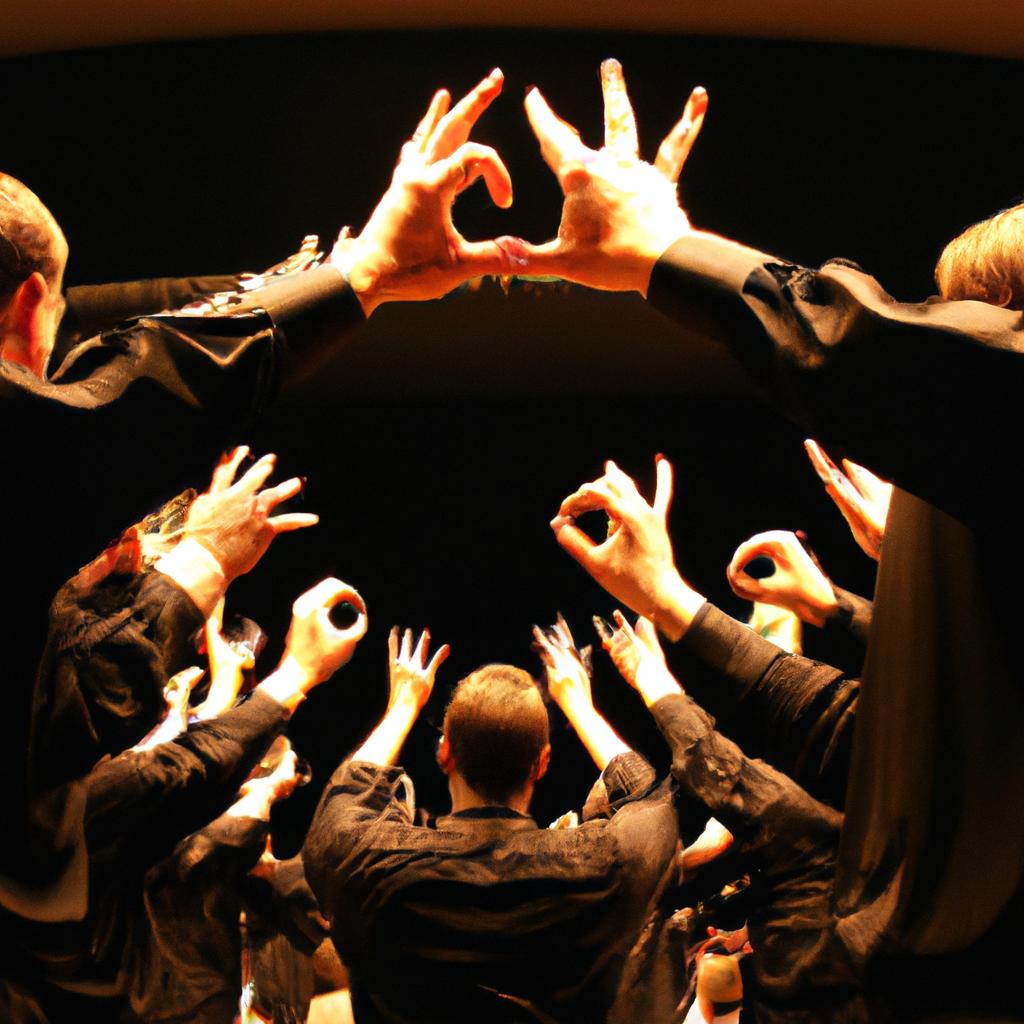The symphony has long been regarded as one of the most significant and complex forms of classical music. With its intricate composition and orchestration, it provides a rich listening experience that captivates audiences worldwide. In this article, we will delve into the origins, structure, and significance of the symphony in classical music.
Imagine attending a concert where you witness an orchestra coming to life before your eyes. The conductor raises their baton, signaling for silence, and then begins to guide each musician through a journey of harmonies and melodies. As the sound fills the concert hall, you are transported to another realm, deeply moved by the power and beauty emanating from every instrument. This is precisely what happens when experiencing a symphony—an exquisite blend of individual talents converging together under one unified vision.
The symphony originated during the Classical era in Europe around the 18th century and quickly gained popularity among composers such as Mozart, Beethoven, and Haydn. It consists of four movements: Allegro (fast), Adagio (slow), Minuet or Scherzo (moderate or lively dance-like movement), and Finale (energetic conclusion). Each movement serves a distinct purpose within the overall structure of the symphony, allowing composers to explore a range of emotions and musical ideas.
The first movement, Allegro, typically serves as an introduction to the symphony. It is often characterized by its lively and energetic nature, setting the tone for the entire piece. Composers use this movement to establish melodic themes that will be developed throughout the symphony.
The second movement, Adagio, provides a contrast to the fast-paced energy of the Allegro. It is usually slower in tempo and more introspective in nature. This movement allows composers to showcase their ability to evoke deep emotions and create beautiful melodies that tug at the heartstrings of listeners.
The third movement can either be a Minuet or Scherzo. The Minuet is a moderate dance-like movement, while the Scherzo is livelier and more playful. Both movements serve as an interlude between the emotional depth of the Adagio and the grand finale of the symphony’s last movement.
Finally, we have the Finale, which brings the symphony to its exhilarating conclusion. This movement is often marked by its high energy and complexity, showcasing virtuosic performances from each section of the orchestra. It ties together all previous movements and leaves audiences with a lasting impression.
The significance of the symphony lies not only in its intricate structure but also in its ability to communicate profound emotion through music. Composers have used symphonies as a means of expressing personal experiences, political ideals, or universal themes throughout history.
In conclusion, symphonies hold a special place in classical music due to their complex composition, orchestration, and ability to convey deep emotions. They provide audiences with an immersive listening experience that transcends language barriers and connects people on an emotional level. Whether it’s Mozart’s elegant melodies or Beethoven’s powerful climaxes, symphonies continue to captivate audiences worldwide with their timeless beauty and artistic genius.
History of the Symphony
Imagine yourself in a grand concert hall, surrounded by rows of elegant seats. The lights dim, and an orchestra takes their positions on stage. As they begin to play, you are instantly transported into a world of captivating melodies and harmonies. This is the power of the symphony, a genre that has captivated audiences for centuries.
The history of the symphony can be traced back to the 18th century when it emerged as a distinct musical form. One notable example is Ludwig van Beethoven’s Symphony No. 5, composed between 1804 and 1808. This iconic piece showcases the symphony’s ability to evoke intense emotions through its dramatic shifts in dynamics and powerful motifs.
To truly appreciate the significance of the symphony, let us delve into its historical context:
-
Classical Period: The origins of the symphony can be found in classical music during the mid-18th century. Composers such as Joseph Haydn and Wolfgang Amadeus Mozart played pivotal roles in shaping this early form. Symphonies from this period were typically written for small orchestras consisting of strings, woodwinds, brass, and timpani.
-
Romantic Era: With the advent of the Romantic era in the late 18th century came a transformation in symphonic composition. Emotion took center stage as composers like Beethoven pushed boundaries with longer works containing intricate thematic development and richer orchestrations.
-
Late Romanticism: In the late 19th century, composers such as Gustav Mahler expanded upon previous innovations, incorporating larger ensembles and exploring new harmonic possibilities within their symphonies. These compositions often conveyed profound emotional landscapes and showcased technical virtuosity.
Now let us take a moment to reflect on how these advancements have touched our souls throughout history:
- The soaring melodies that tug at our heartstrings
- The suspenseful pauses that leave us breathless
- The triumphant climaxes that fill us with exhilaration
- The delicate harmonies that transport us to a world of tranquility
By immersing ourselves in the emotions evoked by symphonic music, we embark on an extraordinary journey through time and human expression.
In the subsequent section about “Structure and Instruments,” we will explore how these emotional landscapes are constructed and brought to life by the intricate interplay of various instruments within the orchestra.
Structure and Instruments
Section: The Symphony: An Informational Article on Classical Music
Previous section H2: History of the Symphony
Transition: Having explored the rich history of the symphony, we now turn our attention to its fascinating structure and the diverse range of instruments employed within this genre.
Structure and Instruments
To better understand the intricacies of a symphony, let us consider an example. Imagine attending a concert hall where a renowned orchestra is performing Beethoven’s famous Symphony No. 5 in C minor. As you sit in anticipation, you are greeted by a grand orchestral ensemble comprising strings, woodwinds, brass instruments, and percussion. Each section has its distinct role but contributes harmoniously towards creating a mesmerizing musical experience.
The following factors contribute to the emotional impact that symphonies have on listeners:
- Dramatic contrast: Symphonies often incorporate contrasting elements such as tempos (fast or slow), dynamics (loud or soft), and tonality (major or minor) to evoke powerful emotional responses from the audience.
- Expressive melodies: Composers skillfully develop melodic themes throughout a symphony, drawing listeners into their musical narrative while evoking emotions ranging from joy to sorrow.
- Harmonic progression: By carefully manipulating chords and harmonic progressions, composers can create tension and release within a symphony, heightening emotional engagement with the music.
- Orchestration techniques: The artful combination of different instrument families allows composers to achieve unique timbral effects, enriching the overall sonic palette of the symphony.
Let us now explore these concepts further through an illustrative table:
| Element | Description | Example |
|---|---|---|
| Dynamics | Varying degrees of loudness or softness | A sudden fortissimo after a quiet passage |
| Tempo | Speed at which the music is performed | A rapid allegro movement contrasting with a largo |
| Tonality | The overall key character of the composition | Shifting from a minor to a triumphant major |
| Orchestration | Arrangement and combination of instruments within an orchestra | Utilizing trumpets for fanfare-like passages |
Transition: Understanding these elements enhances our appreciation for the emotional depth that symphonies can achieve. In turn, this leads us to explore the remarkable composers who have left an indelible mark on this genre.
“.
Famous Symphony Composers
Section Title: The Symphony: An Informational Article on Classical Music
Having explored the structure and instruments commonly found in symphonies, let us now delve into the lives and works of some renowned composers who have made significant contributions to this genre.
Famous Symphony Composers:
One example that highlights the impact of a composer’s work is Ludwig van Beethoven. His Ninth Symphony, also known as the “Choral Symphony,” stands as an influential masterpiece even today. This composition was groundbreaking for its inclusion of vocal soloists and choir alongside the orchestra—a bold departure from traditional symphonic practices at the time.
To further understand the significance of famous symphony composers, consider the following emotional responses often evoked by their compositions:
- Elation: Symphonies can evoke feelings of joy and elation through their triumphant melodies and uplifting harmonies.
- Serenity: Some symphonies captivate listeners with serene passages that create a sense of calmness and tranquility.
- Melancholy: Certain symphonies tug at our heartstrings, touching upon themes of loss or longing, evoking a profound sense of melancholy.
- Triumph: Many symphonies are characterized by grandiose climaxes, instilling a feeling of triumph in those experiencing them.
Table – Notable Symphony Composers:
| Composer | Nationality | Key Works |
|---|---|---|
| Ludwig van Beethoven | German | Ninth Symphony (Choral), Fifth Symphony |
| Wolfgang Amadeus Mozart | Austrian | Jupiter Symphony, Symphony No. 40 |
| Pyotr Ilyich Tchaikovsky | Russian | Swan Lake Suite, Sixth Symphony (Pathétique) |
| Johann Sebastian Bach | German | Brandenburg Concertos, Orchestral Suites |
These composers have left an indelible mark on the history of symphonies and continue to inspire musicians and audiences alike with their immense contributions.
As we have explored some notable composers, it is also important to examine how the performances of symphonies have evolved over time.
[Next section H2: Evolution of Symphony Performances]
Evolution of Symphony Performances
From the grandeur of famous symphony composers, let us now explore the evolution of symphony performances. To illustrate this, let’s consider a hypothetical scenario where a renowned orchestra decides to perform Beethoven’s Symphony No. 5 in a modern setting.
In recent years, symphony performances have embraced innovation and experimentation while still honoring classical traditions. This shift has allowed orchestras to reach broader audiences and adapt to changing times. One notable change is the incorporation of technology into performances. Imagine attending a concert where the stage is adorned with LED screens that display beautiful visual representations inspired by the music being played. These visuals enhance the overall experience for both seasoned patrons and newcomers alike, creating a multisensory journey through sound and sight.
The evolution of symphony performances can be further understood through these key aspects:
- Diverse programming: Orchestras are no longer limited to exclusively performing works from the classical era. The inclusion of contemporary compositions offers an exciting blend of old and new, appealing to a wider range of musical preferences.
- Collaborations: Symphonies have begun collaborating with artists from different genres such as pop, rock, or hip-hop. By fusing various styles together, they create unique experiences that attract diverse audiences who may not typically attend classical concerts.
- Educational initiatives: Many orchestras have developed educational programs aimed at nurturing young talent and cultivating future generations’ interest in classical music. These initiatives often include workshops, masterclasses, and outreach concerts in schools or community centers.
- Accessibility: Efforts are being made to make symphony performances more accessible by offering discounted tickets for students or implementing relaxed dress codes during certain events. Additionally, live streaming concerts online allows people worldwide to enjoy these performances regardless of their geographical location.
To provide a concise overview of these changes in symphony performances, we present the following table showcasing examples:
| Aspect | Example |
|---|---|
| Technology | Visual projections synchronized with music |
| Programming | Performance of contemporary compositions |
| Collaborations | Collaboration between a symphony orchestra and a popular band |
| Education | Youth workshops and outreach concerts |
As the evolution of symphony performances continues to unfold, these changes bring about an exciting transformation in the classical music landscape. The integration of technology, diverse programming, collaborations, and educational initiatives contribute to a vibrant and inclusive environment for both performers and audiences alike.
Transitioning into our subsequent section on the impact of the symphony on society, let us now delve deeper into how these developments have influenced not only the appreciation of classical music but also its broader cultural significance.
Impact of the Symphony on Society
Symphony performances have undergone significant transformations throughout history, adapting to the changing needs and tastes of society. To illustrate this evolution, let us consider a hypothetical scenario: imagine attending a symphony performance in the late 18th century. The concert hall is dimly lit with candlelight, filled with aristocrats adorned in lavish attire eagerly awaiting the commencement of the orchestral masterpiece.
During this period, there were several key developments that shaped the nature of symphony performances:
-
Orchestral Expansion: As musical compositions became more complex, orchestras grew in size and diversity. In addition to strings, woodwind instruments such as flutes and clarinets were introduced, followed by brass instruments like trumpets and trombones. This expansion enabled composers to create richer and grander soundscapes within their symphonies.
-
Conductors Emerged: With increasing complexity, conductors began to play an essential role in guiding the orchestra’s interpretation of the music. They acted as both leaders and interpreters, ensuring cohesion among musicians while expressing their artistic vision through nuanced gestures and cues.
-
Concert Hall Construction: Dedicated concert halls designed specifically for symphonic performances started to emerge during this era. These venues were acoustically optimized to enhance the listening experience for audiences seated across different sections of the hall, allowing them to fully appreciate every nuance of the music being performed.
-
Public Accessibility: Over time, symphony performances gradually moved away from exclusive gatherings for nobility towards a more inclusive atmosphere accessible by individuals from various social backgrounds. This shift was facilitated by public concerts where anyone could purchase tickets at affordable prices or even attend free concerts sponsored by philanthropic organizations.
To further emphasize how these changes impacted society’s perception of classical music, we can examine a table showcasing contrasting features between early symphony performances and modern-day experiences:
| Early Symphony Performances | Modern-Day Experiences |
|---|---|
| Limited audience diversity, primarily aristocrats | Diverse audience representing all walks of life |
| Candle-lit concert halls with limited seating capacity | Technologically advanced venues accommodating larger audiences |
| Exclusive, private events for the upper class | Public concerts accessible to a wider range of people |
| Emphasis on formal attire and decorum | Casual dress codes encouraging inclusivity |
As symphony performances evolved, they transcended their own historical context, becoming cultural landmarks that continue to captivate listeners today. The impact of these changes will be further explored in the subsequent section discussing “Appreciating and Understanding the Symphony.” Through this evolutionary journey, one can grasp how society’s relationship with classical music has transformed over time.
[Transition into next section] By understanding the developments outlined above, we can gain insight into how appreciation and understanding of the symphony have been shaped throughout history. Let us delve deeper into this exploration without delay.
Appreciating and Understanding the Symphony
The symphony has had a profound impact on society, shaping cultural norms and influencing various aspects of human life. One notable example is the case study of Elizabeth Turner, a young woman who attended her first live symphony performance. Prior to this experience, Elizabeth had limited exposure to classical music and was skeptical about its appeal. However, as she sat in the concert hall enveloped by the sweeping melodies and intricate harmonies, something remarkable happened – she was transported into a different world, one filled with emotions that transcended language barriers.
This transformative power of the symphony can be attributed to several factors:
-
Emotional depth: The symphony has an unparalleled ability to evoke deep emotional responses within listeners. Through its complex arrangements and skillful instrumentation, it taps into universal human experiences such as love, joy, sorrow, and triumph. As individuals immerse themselves in these powerful sonic landscapes, they often find solace or catharsis in their own lives.
-
Cultural enrichment: Classical music serves as a repository of collective human history and cultural heritage. Each symphony represents not only the creative vision of its composer but also reflects societal values, historical events, and artistic trends of its time. By engaging with symphonic compositions from different eras and regions, audiences gain insights into diverse cultures while fostering appreciation for artistic achievements throughout centuries.
-
Intellectual stimulation: The complexity and intellectual rigor inherent in many symphonies stimulate cognitive engagement among listeners. Analyzing musical structures or following melodic themes requires active focus and attention. This mental exercise enhances critical thinking skills while promoting personal growth through expanding one’s horizons beyond familiar genres or styles.
-
Community building: Attending a live symphony performance fosters a sense of community among concert-goers. Sharing an awe-inspiring musical experience with fellow audience members creates connections based on mutual appreciation for artistry and shared moments of transcendence. This communal aspect strengthens social bonds and contributes to a vibrant cultural fabric within society.
Emotional Response:
- Listening to a symphony can evoke feelings of nostalgia, transporting listeners back in time.
- The soaring melodies can uplift spirits, elicit goosebumps, or bring tears of joy.
- Witnessing the synchronized efforts of an orchestra can inspire awe and admiration for human creativity.
- Experiencing the power of silence between movements can create anticipation and heighten emotional impact.
Table: Symphony’s Emotional Impact
| Emotion | Description |
|---|---|
| Euphoria | Overwhelming sense of happiness and bliss |
| Melancholy | A deep feeling of sadness or pensiveness |
| Wonder | Awe-inspiring astonishment |
| Tranquility | Calmness and inner peace |
In summary, the symphony is much more than a mere collection of musical notes. Its influence on society encompasses emotional depth, cultural enrichment, intellectual stimulation, and community building. By engaging with this timeless art form, individuals are transported to realms that transcend everyday existence. Whether experiencing euphoria or melancholy, wonder or tranquility, the symphony continues to captivate audiences across generations, leaving an indelible mark upon their lives.




